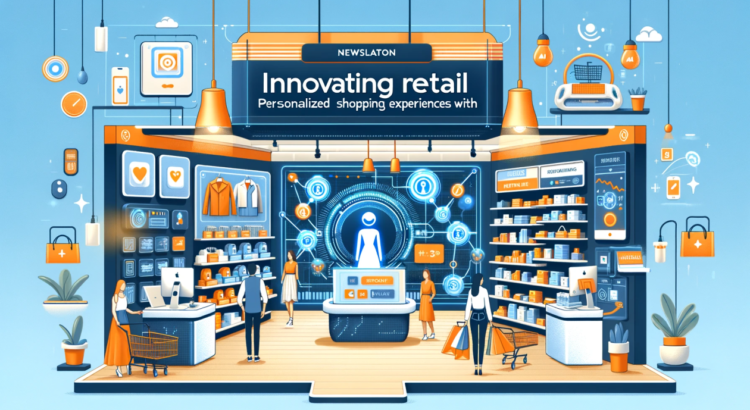Today, customer expectations have changed significantly.Shoppers demand more than just products-they want meaningful experiences tailored to their preferences. Personalization has become the key differentiator in the retail world, and Artificial Intelligence (AI) is leading this transformation. By leveraging vast amounts of customer data, AI enables retailers to understand, predict, and deliver highly personalized shopping experiences at scale.
Understanding Personalization in Retail
Personalization in retail refers to delivering tailored product recommendations, promotions, content, and communication based on a customer’s behavior, preferences, and demographics. This could include showing personalized product listings on an eCommerce site, sending targeted email campaigns, or even changing the homepage layout based on browsing history.
Before AI, this level of personalization was time-consuming and limited in scale. Today, AI can analyze billions of data points in real time to provide a personalized experience for each customer-whether they’re shopping online or in-store.
How AI Enhances the Shopping Experience
AI technologies-such as machine learning, natural language processing (NLP), and computer vision-are being used in various ways to elevate personalization. Here’s how:
1. Product Recommendations
AI analyzes a customer’s browsing history, purchase patterns, cart behavior, and even social media activity to suggest products that are most relevant. Platforms like Amazon and Netflix are known for their recommendation engines, but even mid-sized retailers can now implement similar models thanks to scalable AI services.
2. Dynamic Pricing
AI allows retailers to adjust pricing dynamically based on demand, competition, user profile, and purchase history. For instance, a loyal customer might see a discounted price for a product they frequently view, encouraging them to complete the purchase.
3. Predictive Analytics
By identifying trends and behaviors, AI can predict what a customer might need before they even search for it. A fashion retailer could, for example, recommend a raincoat to a user in a region expecting showers based on weather data combined with browsing patterns.
4. Chatbots and Virtual Shopping Assistants
AI-powered chatbots provide real-time assistance to customers, helping them find products, solve queries, and make decisions. These assistants use NLP to understand customer intent and can even simulate human-like conversations, creating a more interactive experience.
5. Visual Search and Voice Assistants
Computer vision enables visual search features where a shopper can upload a photo to find similar products. AI-driven voice assistants like Siri, Alexa, and Google Assistant are also becoming increasingly integrated into retail platforms, letting users shop hands-free using just their voice commands.
6. Customer Segmentation
AI can divide a retailer’s audience into micro-segments based on buying patterns, geography, and preferences. This allows for hyper-targeted marketing strategies that are much more effective than generic campaigns.
7. Inventory and Supply Chain Optimization
Behind the scenes, AI helps personalize shopping by ensuring the right products are available at the right time. It predicts which items are likely to be popular, enabling better inventory planning and restocking, which directly enhances customer satisfaction.
Benefits of AI-Driven Personalization
- Increased Customer Engagement: Tailored experiences foster stronger emotional connections with the brand.
- Higher Conversion Rates: Personalized recommendations and offers lead to better decision-making and more purchases.
- Improved Customer Loyalty: When customers feel understood, they’re more likely to return.
- Reduced Cart Abandonment: AI can trigger personalized follow-ups or incentives to help close a sale.
- Operational Efficiency: AI automates decision-making and reduces manual efforts across marketing, sales, and logistics.
Challenges to Consider
While AI offers tremendous potential, it also comes with challenges:
- Data Privacy: Collecting and analyzing user data must comply with regulations like GDPR and DPDP. Transparent consent practices are essential.
- Implementation Costs: Developing and maintaining AI systems requires investment in infrastructure and talent.
- Bias in Algorithms: If AI models are trained on skewed data, the output may reinforce existing biases or result in unfair recommendations.
Future of AI in Retail Personalization
The future will see even deeper integration of AI with personalization, fueled by developments in deep learning and real-time data analytics. Retailers may move toward creating entirely personalized storefronts for each user, where every aspect of the shopping experience-layout, products, pricing, promotions-is uniquely tailored.
With advancements like emotion recognition, augmented reality (AR), and generative AI, the boundary between digital and physical shopping will continue to blur. Virtual try-ons, immersive product experiences, and voice-based shopping will become the norm rather than the exception.
Final Thoughts
AI is not just a tool-it’s a strategic enabler for brands aiming to deliver richer, more relevant shopping experiences. Personalization through AI fosters customer satisfaction, loyalty, and long-term business growth. Retailers who embrace AI-driven personalization will not only stay ahead of the competition but also create meaningful engagements that resonate with modern consumers.
At Razorse Software, we help businesses harness the power of AI to create intelligent, personalized, and scalable shopping platforms. Whether you’re building a new eCommerce solution or looking to enhance your current one, our AI-driven strategies can elevate your customer experience and increase ROI.
#AIinRetail #PersonalizedShopping #EcommerceInnovation #RazorseSoftware #DigitalExperience #AIPoweredSolutions #SmartRetail





